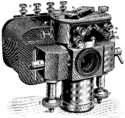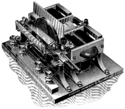William Duddell facts for kids
William Du Bois Duddell (born July 1, 1872, died November 4, 1917) was an amazing English scientist and electrical engineer. He invented several important tools. These include the oscillograph, which helps us see electrical signals. He also created special meters like the thermo-ammeter and thermo-galvanometer.
Life and Career
William Duddell was born in Kensington, London. Even as a young child, he loved to build things. When he was only four years old, he made a toy mouse move using clockwork! His younger sister, Gladys Duddell, became a famous tennis player.
William went to private schools in England and France. He was very smart and quickly earned scholarships to study at the important City & Guilds Schools. He sadly passed away when he was 45 years old.
Duddell's "Singing Arc"
Before light bulbs were common, people used arc lamps to light up streets. These lamps made light from an electric spark between two carbon rods. But they often made loud humming or hissing noises!
In 1899, Duddell was a student at London Central Technical College. His teacher asked him to figure out why these lamps were so noisy. Duddell discovered the sounds came from unstable electric currents.
He found a clever solution. Duddell connected a special circuit to the arc lamp. This circuit had an inductor (a coil of wire) and a capacitor (a device that stores electricity). When connected, this circuit could create musical tones from the arc!
Duddell used his oscillograph to study these sounds. He even connected a keyboard to the arc lamp. This allowed him to play different notes. He played the song God Save the Queen for an audience in London. This was one of the very first times electronic music was ever made! His invention became known as the "singing arc." It was one of the first electronic oscillators, which are devices that produce repeating electronic signals.
Duddell's singing arc could only make sounds. But later, two Danish scientists, Valdemar Poulsen and P. O. Pederson, improved his idea. In 1902, they made an arc that could create radio waves. This invention, called the Poulsen arc, was the first radio transmitter that could send out a steady radio signal. Poulsen arc transmitters were used all over the world for radio communication until the 1920s.
Honours and Awards
William Duddell received many important awards for his work. In 1907, he became a Fellow of the Royal Society. This is a very high honour for scientists. The British Institute of Physics even named a special award, the Duddell Medal and Prize, after him.
He was also the president of the British Institute of Radiology from 1907 to 1908. In 1912, he became the youngest ever president of the Institution of Electrical Engineers. He served two terms in this role.
Duddell was also invited to give the famous Royal Institution Christmas Lectures twice. He spoke about "Signalling to a Distance" in 1906 and "Modern Electricity" in 1911.





